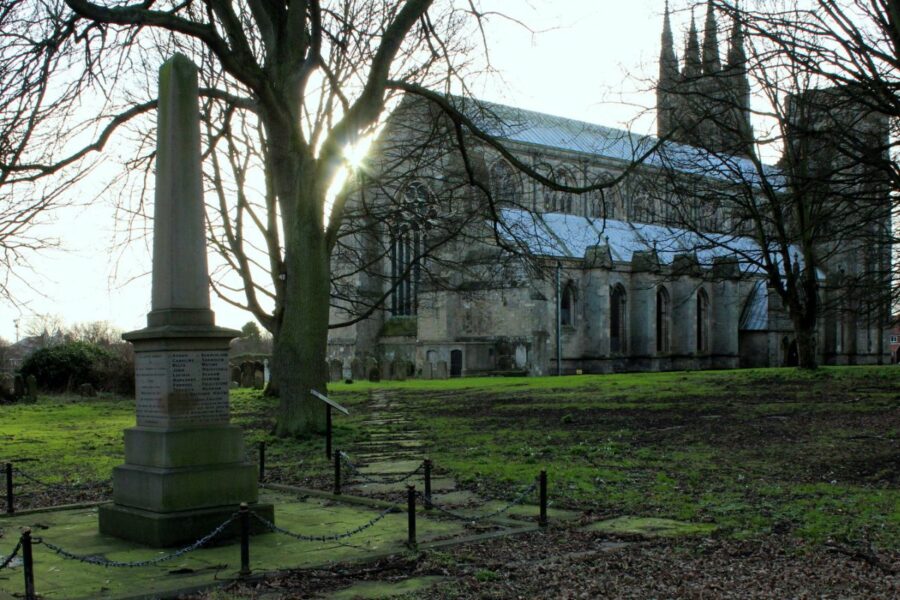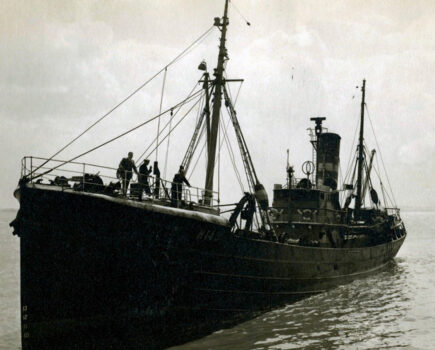Last year marked the 150th anniversary of one of the UK’s worst maritime disasters, when some 70 sailors, fishermen and lifeboatmen were lost off Bridlington. Brian W Lavery reports…
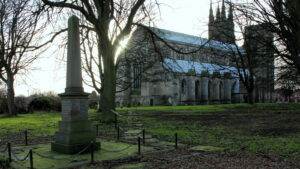
The memorial to those lost in the Great Gale of 1871, which claimed scores of men and vessels in one of the country’s worst-ever maritime disasters.
Behind Bridlington’s Priory Church is a 151-year-old weather-beaten obelisk commemorating those claimed by the ‘Great Gale’ of 1871.
It stands as a memorial to one of the country’s worst maritime disasters and is the final resting place of 43 sailors. Six local lifeboatmen also lie among the dead.
Scores were lost and it is estimated that up to 30 vessels perished when disaster struck on Friday, 10 February that year.
For a century and a half on the Sunday nearest to the date of the catastrophe, a service has been held to mark what is known locally as Fishermen’s Sunday.
In 1871, Bridlington had two separate lifeboats, the RNLI’s Robert Whitworth and ‘the fishermen’s lifeboat’, the Harbinger.
The fishermen’s boat was gifted to the town by Hungarian émigré Count Gusztáv Batthyány, an Anglophile refugee who loved his adopted port town.
Both boats were launched multiple times that day, and were to save many lives – but Harbinger was almost lost attempting to save the crew of a brig when a series of giant waves capsized her. She got back by chance, washed ashore in the maelstrom after losing her oars. Six of her nine crew drowned.
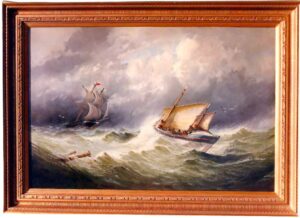
A painting by an unknown artist – possibly William Broome – of a pulling and sailing lifeboat going to the aid of a stricken vessel in a storm. The Great Gale sparked a series of such paintings. This one is part of the RNLI art collection at the RNLI Support Centre, Poole. It is not currently on display.
Just 48 hours earlier, the weather was fine. It was a much-needed calm period. The winter had been dreadful, and many vessels had been unable to sail for some time. The break in the weather meant that voyages could resume.
The day before, many ships had reached Bridlington Bay when the wind dropped, causing them to stand idle.
Many folk went sightseeing to witness the becalmed flotilla of between 300 and 400 ships in the bay, among them many ‘colliers’ (coal-carriers).
The bay was renowned among mariners and fishermen as a safe haven. The vessels anchored there, and awaited a fresh breeze. But soon the wind changed from a northwesterly to an easterly, which rapidly became gale-force. Skippers feared this, as it turned the haven into a death trap.
Barques, brigantines, brigs and other sailing vessels had set off from the Tyne laden – many overladen – with coal. There were no safety-at-sea laws back then.
Soon a roaring gale was joined by flurries of sleet, snow and ice. Normally in these conditions the accepted wisdom was to avoid the shore – but these vessels were now being pummelled.
The power of the sudden storm was such that it pulled ships from their anchors. They could not head to the relative safety of the North Sea because it meant negotiating the dangers of nearby Smithwick Sands.
These sands could tear the bottom from a ship, and many of the vessels were in notoriously poor states of repair, as well as being loaded to the gunnels. They were trapped.
Some masters began to run their vessels ashore, in the hope they would be rescued. Others decided to try to weather the storm.
Bridlington’s two lifeboats – the fishermen’s Harbinger and the RNLI’s Robert Whitworth – were launched at different points in the day and from different parts of the shore. The former did not meet RNLI standards, but was well-loved by her crew, who were mostly fishermen.
Both lifeboats made multiple heroic launches that day against the unrelenting gales and saved dozens of lives, but they also witnessed the loss of more.
Sightseers who had earlier enjoyed watching the becalmed flotilla were now terror-stricken, powerless spectators of a terrifying display of nature’s power – and men’s brave but feeble efforts against it.
Crowds gathered on the harbour and promenade. Some gathered at the sea walls to give what help they could.
The Bridlington Rocket Company tried in vain to fire lines into the surging seas, while shouting to men to jump ship and try to wade ashore.
Coastguards waded into the sea to try to convince terrified men to come towards them through the raging surf.
Many vessels ran into the killer sand, flooded rapidly and sank in seconds. Men clambered onto riggings and screamed for help.
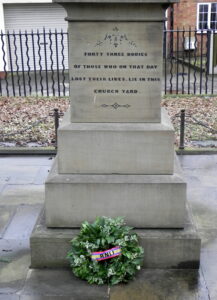
The memorial obelisk, with a wreath laid by the coxswain of the RNLI’s Bridlington crew, as has been the tradition since 1871.
At one point, 17 vessels came ashore simultaneously, and all of them were smashed to pieces. Wrecks piled up all along the shore.
Lifeboat crews fought hour after hour to save lives. Robert Whitworth rescued four crewmen from a vessel called Friends Increase, and then saved six men apiece from ships called Echo and Windsor.
For a further two hours they fought to reach another vessel in distress. They could not. That ship went down with all hands.
When they got back to the harbour, the crew had to be lifted from their seats because they were so exhausted. The lifeboat was taken out of service.
Wrecks continued to hit the shore and smash up. Dead bodies and debris continually landed all along the coast. One ship attempted to enter the harbour, but was smashed against the stone pier and broke up.
A coal brig also tried to come into port, but was carried past the harbour entrance and disintegrated, her bottom torn out by the sands.
The fishermen’s boat Harbinger tried to launch from the harbour, but could not get past the entrance. Dozens of men had to carry the lifeboat to the beach to be launched.
Count Batthyány received a telegram from local carpenter David Purdon, who had built the Harbinger, to say that the little boat had saved five crews so far.
As crews got exhausted, others went in their place – but after five trips, there were not enough fresh volunteers. It was proving difficult to get men to come forward until David Purdon and his assistant volunteered. Seeing this encouraged others, and soon the Harbinger was out to save more lives.
There were nine men aboard as she went out to reach a brig, the Delta, which had run aground and looked likely to break up.
En route, Harbinger saw another vessel grounded, rescued five sailors from it, returned them to shore, and then headed back to the Delta.
When Harbinger drew near, the crew could see only one man. He was hanging onto some rigging and was clearly terrified. The crew called for him to jump, but he was too scared to make the leap.
Harbinger came in for a second attempt and again urged the man to jump. He would not budge.

The flag and bunting of the RNLI in Bridlington Priory Church for Mike Wilson. Fishermen’s Sunday.
A massive wave struck the ship, and the splashback rocked the lifeboat. Then a second wave hit. Harbinger capsized. She floated upside down until another giant wave righted her.
One man, Robert Hopper, managed to clamber back aboard, and found another man, Richard Bedlington, who had somehow stayed with the vessel. Hopper spotted his shipmate John Robinson in the raging waters and threw one end of his scarf to him. Robinson grabbed it, and was dragged back onboard.
The vessel was thrown around in the waves like a cork in a whirlpool. Harbinger came ashore at Wilsthorpe near Bridlington, severely damaged. Her rescue work that day ended there. The three men were incredibly lucky to survive, having been left oarless on the badly damaged boat.
Their six comrades had no such good fortune. David Purdon, the boat’s builder, perished along with his assistant John Clappison and crewmen Richard Atkin, William Cobb, Robert Pickering and James Watson. The frightened man they had tried to save drowned too.
The day after the tempest, the coast was littered with the wreckage from dozens of boats. Bodies washed ashore over the following days and weeks.
In the calm that followed, the beaches of the East Yorkshire coast were dotted with clothing, coal, boots, sails and other debris. In some places it was piled up to 10ft high. Many of the townspeople gathered coal from the shores, even as they searched for loved ones.
Bodies were taken to a nearby public house, the Albion, where they were photographed. In the weeks that followed, relatives of dead fishermen and sailors came to Bridlington to claim their dead. There were bodies still being found months later.
Of course, there is little that humanity can do in the face of nature’s power – but many of the vessels that perished that night were not seaworthy. In modern terms, they were death traps.
Many went to sea overloaded and under-maintained, and a lot of the vessels had rotted timber which gave way under the least pressure. Ships that ran into the dangerous sands had the bottoms ripped from them much quicker than would have been the case if the owners had had even scant regard for the men who made them rich.
It is estimated that around 70 lives were lost and that at least 30 vessels perished in the Great Gale – but 60 men did find their way to shore.
On St Valentine’s Day 1871, the shops of Bridlington were closed. Schools were given a half-day holiday for the mass funeral in the town. Ships in the harbour flew flags at half-mast. Thousands lined the roadside on the funeral procession route, which ended in the Priory Church.
The monument to those who gave their lives to save their fellow seafarers was paid for by public subscription. In the old churchyard, the faded tombstone of David Purdon lies between those of James Watson and Robert Pickering.
James Watson’s widow was driven mad by grief, and died in the York Asylum, where she was placed just days after the storm that took her husband. Harriet Purdon, David’s widow, died in childbirth soon after the catastrophe.

The grave of David Purdon, who built the Harbinger, in the centre, with the gravestones of James Watson and Robert Pickering on either side.
A fund set up for the families attracted donations from around the country.
Harbinger was restored as the fishermen’s lifeboat, and served in that role in Bridlington until December 1886.
Each year since 1871, the Bridlington lifeboat crew, led by its cox, has attended the Fishermen’s Sunday commemoration at the Priory Church.
This year, there was to be a memorial service and procession to mark the 150th anniversary of the Great Gale – but due to Covid-19 restrictions, plans had to be altered.
The church service was livestreamed from the Friends of Bridlington Priory Facebook page, and a wreath was laid at the memorial. Another wreath was taken to sea.
A restored lifeboat from the Whitby Historic Lifeboat Fund was due to be pulled in mass procession through the town, following the route of an original funeral procession, but this was postponed. There are plans to commemorate the anniversary later in the year, when coronavirus restrictions allow.
If anything good came from this devastating disaster – other than the support for those bereaved – it must be the introduction of the Plimsoll Line, which indicates the safe level to which a vessel can be loaded.
The Derby MP Samuel Plimsoll, after whom it is named, was also instrumental in bringing about the Merchant Shipping Act of 1876.
All pictures courtesy of the RNLI.
The writer gratefully acknowledges the books The Great Gale by Richard M Jones and History of Bridlington by Mike Wilson.
This story was taken from the archives of Fishing News. For more up-to-date and in-depth reports on the UK and Irish commercial fishing sector, subscribe to Fishing News here or buy the latest single issue for just £3.30 here.

